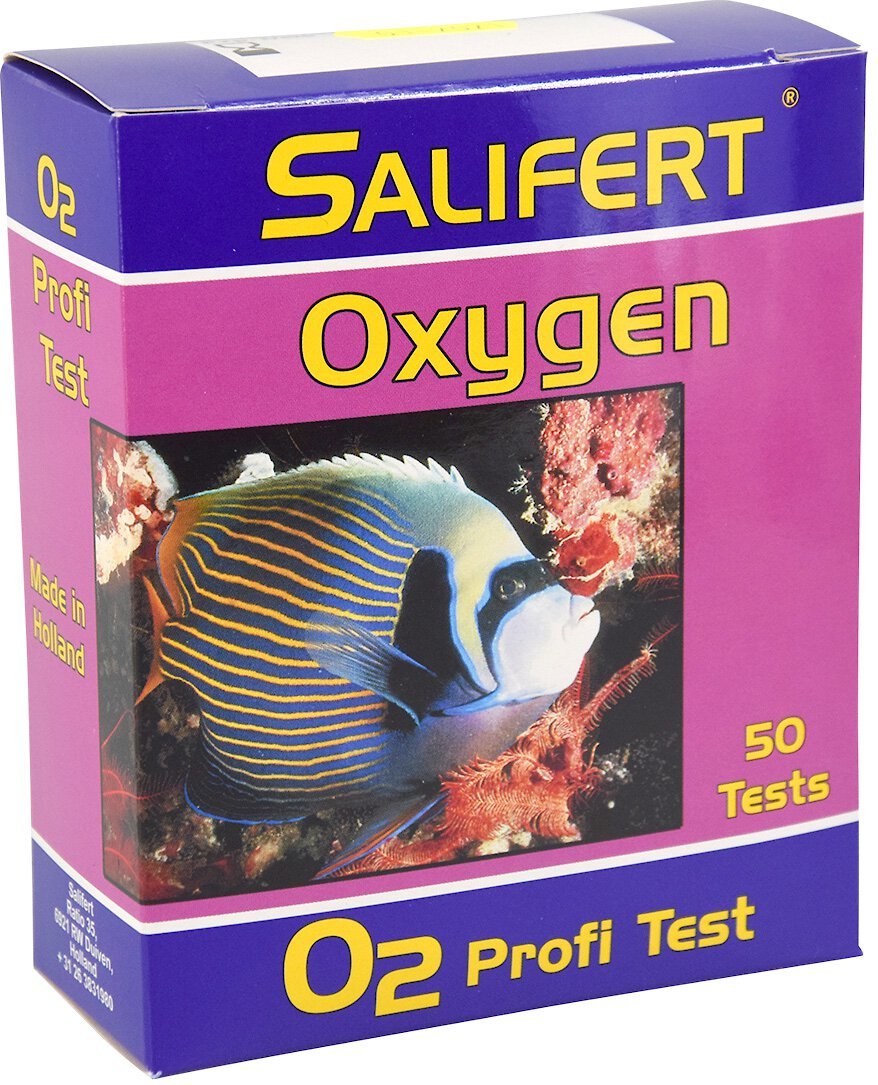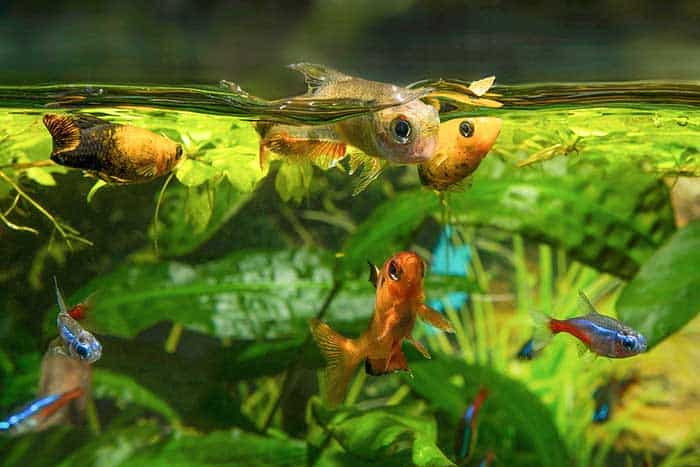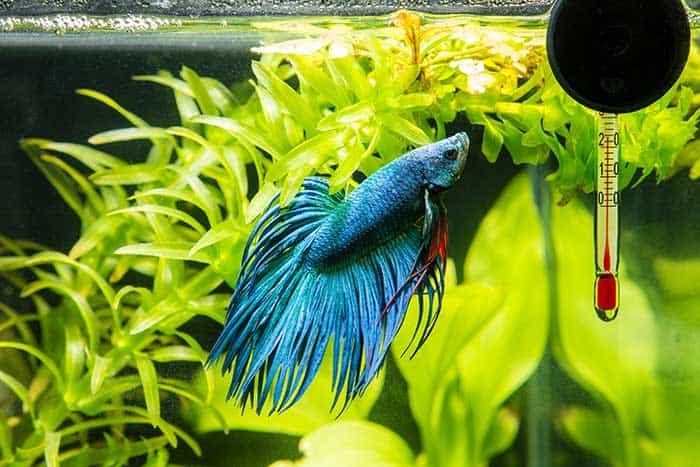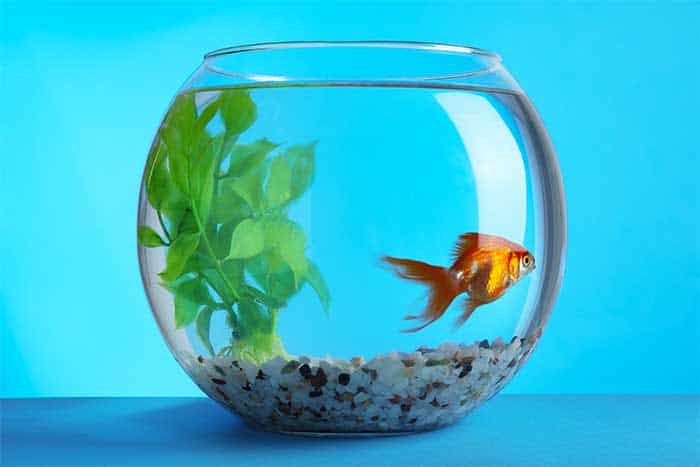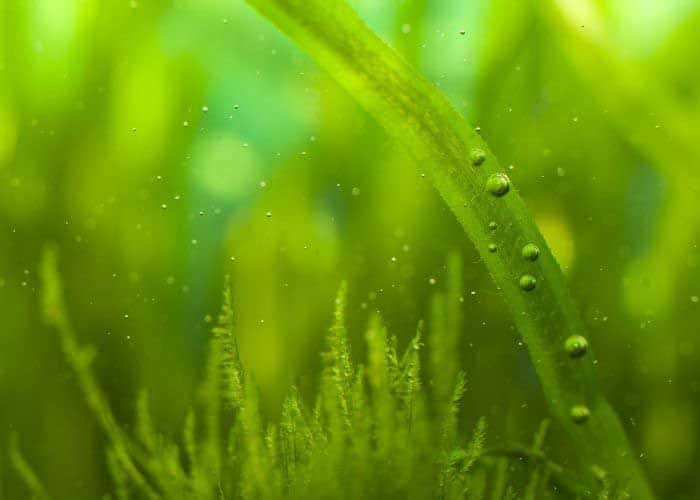How Do You Oxygenate A Fish Tank (and why you need to)
There are several things to learn as an aquarist, and keeping your fish tank properly aerated is vital for healthy fish. Oxygen plays an important role in an aquarium, such as helping your fish to breathe, maintaining healthy plant life, stabilizing water parameters, and creating a healthy biological environment. So how do you oxygenate a fish tank?
The best ways to oxygenate a fish tank are:
- Using an air pump – This is the most popular and easiest way to oxygenate a fish tank.
- Using an air stone – This is a great way to oxygenate your tank and can create a wonderful column of bubbles.
- Adding plants – This is another great way to oxygenate your tank and is also a pleasant decoration.
- Adding an aquarium filter – Most fish tanks have a filter, so this is an easy method but not always as effective.
There are also some effective ways to add oxygen manually, especially in an emergency.
Throughout this article, I explain how oxygen works in an aquarium, how to test the oxygen levels in your tank, and why it is important. I will also take a closer look at the most effective ways to aerate your fish tank.
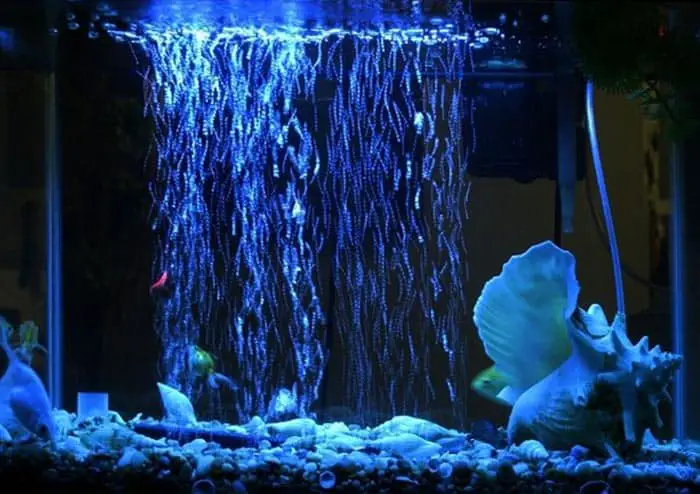
It’s also important to keep an eye on other water parameters in your aquarium, such as pH and Water Hardness. The articles below can help you to learn about these topics.
Fish Tank pH Levels (An easy guide for fishkeepers)
How to soften aquarium water (Quick and easy solutions)
Do Fish Need Oxygen In A Tank?
Fish need to breathe just like all animals, and their tanks need to have a good oxygen supply to keep them healthy. The amount of oxygen in the water is called the “oxygen saturation level” or just “saturation.”
Although a few fish can breathe oxygen straight from the atmosphere, most fish need dissolved oxygen in the water to survive. The higher the saturation level, the more dissolved oxygen is available for the fish to breathe.
Oxygen enters the water through a gas exchange process, which is where carbon dioxide is released into the air in exchange for oxygen. You can read more about the gas exchange process in the following article: Do Goldfish Need An Air Pump To Help Them Breathe.
As oxygen enters the water, it dissolves or saturates, hence why it is called dissolved oxygen and is measured as oxygen saturation.
How Much Oxygen Does My Fish Tank Need?
The oxygen level in water is measured in parts per million (ppm), and although each fish species is different, most freshwater fish tanks will do just fine with an oxygen level between 5-8 ppm.
Aquarium water temperature directly impacts how much oxygen can saturate the tank water. Cold water has a higher oxygen concentration than warm water of the same quality.
If an aquarium’s temperature is set too high, this alone can cause breathing problems in your fish and should be one of the first things to check if your fish show signs of labored breathing.
Signs Of Low Oxygen In Aquarium
There are several signs of low oxygen in an aquarium, such as your fish gasping for air, usually at the surface, or fish that are staying close to surface water agitation. You may also notice that your fish are less active and are sleeping more with more gill movement than usual.
Surface water agitation is required to kick-start the gas exchange process helping to release carbon dioxide from the water and allowing oxygen to enter. Fish will naturally gather at a point of surface water movement where there will be a better oxygen concentration.
Fish Gasping For Air
If your fish are gasping for air, this is the most obvious sign that they are struggling to breathe and is a great indication that your tank lacks the correct oxygen level.
Fish breathe by passing water over their gills and extracting oxygen in the process. When oxygen levels drop, fish will need to pass more water over their gills to extract the required oxygen, and this increased gill movement will look like they are gasping.
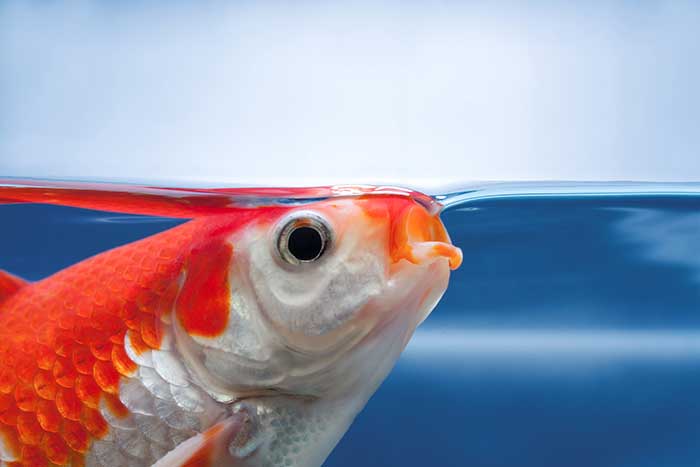
You should be aware that gasping is not always related to a low oxygen supply and can instead be a sign of illness in your fish. It is quite easy to check the oxygen saturation level in your tank by using an oxygen test kit. If, after correcting any imbalance, your fish is still gasping, you will need to look for other symptoms or speak with a veterinarian or other specialist for advice.
What Does A Fish Gasping For Air Look Like?
When a fish is gasping for air, you will notice the gill movement increase in speed, and it will be ongoing. Fish will usually be quite still while their mouths open and close rapidly as they suck water in.
A fish that has been swimming vigorously around the tank may be out of breath for a short time and gasp momentarily compared to a fish that is not getting enough oxygen and will gasp nonstop until oxygen levels increase.
Fish Gasping For Air At Top Of Tank
When oxygen levels are low, you will often see fish swimming at the top of the tank gasping for air. The water surface is where oxygen enters, so fish will often gather here because it is the most oxygen-rich area.
Some fish, such as betta fish, can breathe oxygen from the atmosphere because they have a labyrinth organ. This is not common in fish, and they will often pop their heads above the surface to breathe when the tank’s oxygen levels are low or during poor water conditions.
Fish Gasping Near Filter
If you have a filter that creates surface agitation as water is expelled, you may find your fish gasping in this area of the tank. Surface agitation from the filter will allow oxygen to enter the water more easily, and it is one of the best ways to oxygenate your tank.
Unless the filter you are using creates a powerful current, the amount of agitation at the water surface will not be enough to aerate the whole tank and other methods will be needed to increase oxygen absorption, which I will cover shortly.
Fish Breathing Fast At Bottom Of Tank
Although surface gasping is the most common sign of poorly oxygenated water, sometimes fish will remain at the bottom of the tank, even resting on the bottom. Gasping at the bottom of the tank is often a sign that your fish are running out of energy.
You will need to improve the oxygen level as soon as possible to prevent fatalities from occurring.
Fish Swimming At Top Of Tank At Night
Fish are more likely to be found swimming at the top of the tank at night if you have a good amount of live plants. Plants provide oxygen during daylight hours, which will help to aerate your tank, but at night, your plants will feed on oxygen, leaving less for your fish to breathe.
You may think that you should leave your aquarium light on to combat this, but it will only increase algae growth and is unnecessary.
Fish and live plants both need a period of daylight and darkness to complete their own biological cycle and to remain healthy. If your tank has live plants and oxygen-rich water, it shouldn’t struggle to maintain a satisfactory oxygen level throughout the night.
What Are The Signs Of Too Much Oxygen In A Fish Tank?
Too much oxygen in a fish tank can be a problem for your fish, although it is not as common as low oxygen levels. Too much oxygen is called hyperoxygenation and can lead to gas bubble disease, a potentially fatal condition where bubbles develop in your fish’s bloodstream.
There are several signs that can signal too much oxygen in a fish tank, such as:
- Excessive bubbles naturally occur in the water.
- Bloating in fish can be caused by excess oxygen in the body.
- Bubbles appear beneath your fish’s skin or around the eyes.
- Increased appetite in your fish.
- Your fish may become more energetic or the complete opposite, showing signs of lethargy.
- Disorientated or spinning fish.
- Fish breathe at the surface (out of the water) for an extended period of time, trying to take in some carbon dioxide from the air instead of the excess oxygen in the water.
- Fish remain at the bottom of the tank for an extended time where oxygen levels are lower.
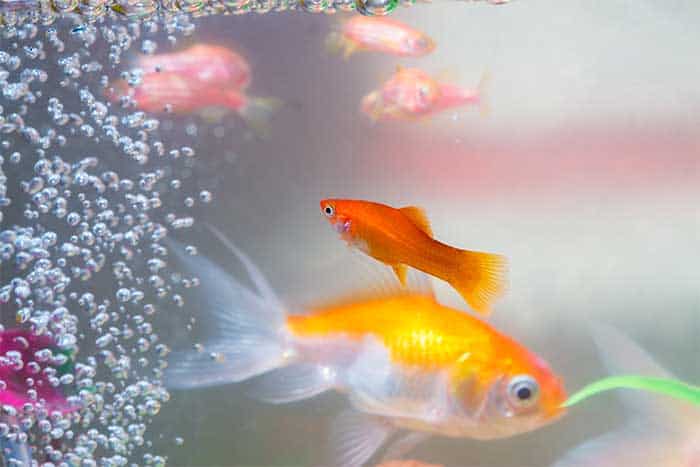
Important Note
If oxygen levels are too high after testing, symptoms should disappear when oxygen levels have been reduced.
Any physical symptoms in fish can also indicate other illnesses. I recommend getting a second opinion or speaking directly with an expert if you are unsure.
Too much oxygen is not the only cause of gas bubble disease. In fact, excess nitrogen is a far more common cause, so you will need to check the water for both of these if you suspect your fish has this disease.
How Much Oxygen Do Fish Need?
Most freshwater fish require approximately 6-8 ppm (parts per million) of dissolved oxygen in their tank. Many fish will become stressed when oxygen drops below 5 ppm and usually cannot survive with prolonged oxygen levels below 2-3 ppm.
Generally, fish tank water won’t hold more than 10ppm of dissolved oxygen, which, dependent on water temperature, is around 110% saturation. If you have a dissolved oxygen reading above 10 ppm, you should watch your fish’s behavior and consider some natural ways to reduce the level to below 10 ppm.
The figures listed above are approximate, and there are always exceptions, such as goldfish, betta fish, and gouramis which require much less dissolved oxygen to survive.
Can Too Much Oxygen Kill Fish?
Too much oxygen can kill fish, even when over a short time. Too much aeration in a fish tank can lead to gas bubble disease, which I mentioned previously. Gas bubble disease is dangerous for fish, and it can upset the general biology of your tank, including live plants and micro-organisms.
In the unlikely event that your fish tank does have a dissolved oxygen content high enough to cause gas bubble disease, then you will need to reduce the level of oxygen immediately, and you will need to find out why your tank has become over-oxygenated to avoid it happening in the long term.
How To Reduce Oxygen In A Fish Tank
To reduce the dissolved oxygen content of your fish tank, you will need to increase the level of Carbon Dioxide (CO2). Reducing oxygen is best done gradually by identifying everything that is oxygenating the tank and removing them one at a time until oxygen levels fall within the correct parameters.
Look at the below list and remove or remedy each item starting from the top and gradually working through the list until oxygen levels settle within the correct range.
- Turn the fish tank lights off at night. Allow at least 8-10 hours of darkness where plants will consume oxygen in the water. During daylight, plants will feed on CO2 and will release oxygen into the water. Low lighting throughout the day will reduce the amount of oxygen released by your live plants.
- Check your water temperature. Warmer water will naturally hold less oxygen, so check that the temperature is not too cold for the species of fish in your tank.
- Stir the water slowly. Oxygen is often spread unevenly through the tank, with more oxygen at the surface than at the bottom. Stirring the water slowly will help distribute the oxygen more evenly until you can find a more permanent solution, such as a stronger filter, to increase the water current.
- Remove or trim some plants if you feel your tank is overplanted. Live plants are great for the overall biology of your tank and will add oxygen throughout the day. Too many plants used in combination with other aeration devices may cause over-oxygenation.
- Remove or reduce the power of an air pump. Air pumps cause a column of air bubbles in your tank. They are often a great visual feature and ideal for adding extra oxygen.
- Decrease the flow rate of your filter. If your filter’s flow rate is quite strong, it will often create a lot of surface water disturbance which will aid the gas exchange process, helping oxygen to enter the water and CO2 escape from the water. Ensure your filter flow rate is still strong enough to keep the tank clean.
- Add more fish to your tank. If your fish tank is understocked, adding more fish to compete for oxygen is a good long-term solution.
How To Reduce Oxygen In A Fish Tank Quickly?
A quick way to remove oxygen from a fish tank would be to add carbonated water or seltzer water. This is a trick often used to suffocate unwanted pests and suffocate your fish if done incorrectly.
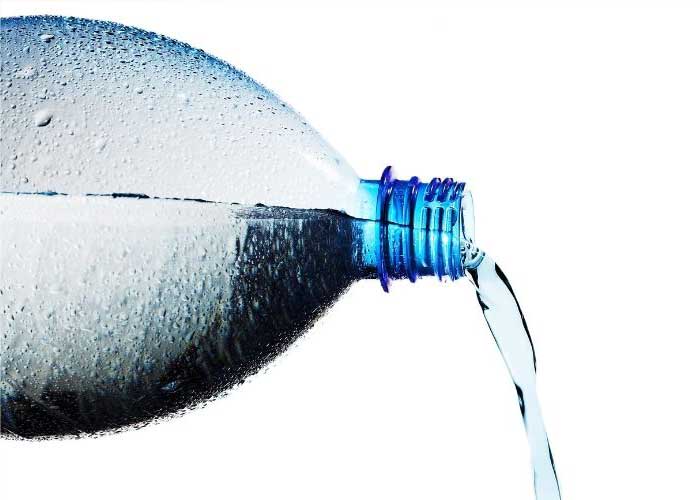
If fish are in the tank I would only suggest using this method if you think your fish have gas bubble disease and are looking for an emergency solution.
When using carbonated water, make sure there are no harmful additives and use only a small amount relative to the size of your tank, otherwise, you will create a low-oxygen situation. A larger tank will require more carbonated water.
Carbonated water will quickly increase CO2 levels in your tank while reducing the oxygen content. The effect is only short-term, but it will allow you time to identify what is over-oxygenating so that you can remove it.
Read this section of an article I wrote on removing Scuds from an aquarium. It will detail how carbonated water can be used, precautions, and side effects: How To Remove Scuds In An Aquarium By Increasing CO2 Levels.
How To Test Oxygen Levels In Aquarium?
The easiest way to measure your fish tank’s oxygen level is to use a test kit. Many test kits are available, or you can invest in an electronic dissolved oxygen meter for even more ease and convenience.
Dissolved Oxygen Test Kit
Most dissolved oxygen test kits will take a sample of water in a test tube to mix with another solution and will give a reading when compared to a measurement chart supplied in the kit.
Below is one of the test kits that I use.
Salifert Dissolved Oxygen Test Kit
The Salifert dissolved oxygen test kit can accurately and immediately perform checks within minutes so that you will know your fish are swimming in a safe and healthy environment.
These tests are ideal for testing oxygen levels in freshwater and saltwater aquariums as well as ponds.
Dissolved Oxygen Meter For Aquariums
A dissolved oxygen meter is more expensive than the standard test kit, but it is also more convenient and ready to use without all of the hassles of using test tubes and other solutions.
If you are just a hobbyist with a single tank, a digital meter is probably a little overkill (unless you can afford one.)
Investing in a dissolved oxygen meter is also cheaper in the long run as you will not need to buy further test kits when they run out.
Portable Dissolved Oxygen Meter
Portable dissolved oxygen meters are useful tools because they provide accurate, fast measurements, which are perfect for hobbyists who may need to make quick decisions about the health of their fish.
The meters are electronic and use a sensor to detect dissolved oxygen levels in water or other liquids.
You can buy digital dissolved oxygen meters like the one I use below from Amazon. (affiliate) link included.
How Do You Oxygenate A Fish Tank?
Adding oxygen to a fish tank is quite a simple task and usually happens naturally with the correct tank setup. A bioactive tank setup will naturally supply oxygen via live plants. Setting up a tank with a good level of bioactivity requires patience and a good balance of plants, fish, and bacteria.
Do Bubblers Put Oxygen In Water?
Bubblers are basically any device connected to an air pump that will expel a column of air bubbles and are a great way of adding fresh oxygen to larger fish tanks. They are not usually necessary in smaller tank setups, but they can be quite eye-catching when connected to a compatible ornament.
A popular choice for many fishkeepers is a clam type of ornament that, when connected to an air pump, will open and close as air escapes into the tank.
Air stones are also a popular choice and connect to an air pump. Air stones are porous stones that create a smooth column of smaller air bubbles that are more easily dissolved into the water.
How Do You Oxygenate A Fish Tank Without A Pump?
Any method that causes surface water disturbance will aid in the gas exchange process I talked about earlier. A good filter will create a good level of water movement and cause disturbance to a wider surface area to help more oxygen enter the water.
How To Add Oxygen To A Fish Tank Quickly
If you are struggling with low oxygen levels in your fish tank and need a quick boost of instant oxygen, there are a few things that you can do.
- Add an air pump. A battery-powered air pump is a good option to use as a temporary solution and can add just enough oxygen to the aquarium water to bring levels back in line. A more permanent solution is a mains-powered air pump which is more adjustable and usually maintenance-free.
- Lower the water temperature a little. Cooler aquarium water will hold more oxygen, so providing your fish can tolerate the cooler temperature, it will help increase oxygen levels while you find a more long-term solution. You can also add ice cubes to bring the water temperature down quicker, especially in larger tanks.
- Use a jug to pour water into your tank. Slowly pouring water into your tank from a height will create enough disturbance to the surface area and help oxygen enter the water quickly. Instead of adding fresh water, just fill your jug with water from the tank.
- Create some surface agitation. Use anything you can to increase surface agitation, gently splashing or stirring the water.
- Add an oxygen tablet. Oxygen tablets are a quick and easy way to add fresh oxygen to your tank water in a pinch. Usually used for transporting fish or during very warm periods, oxygen tablets will dissolve in the water, releasing oxygen for several hours.
- Increase your filter flow rate. If you have an adjustable flow rate on your filter, simply increasing the flow rate will not only increase surface agitation but will also help with water circulation so that oxygen will be better distributed around the tank.
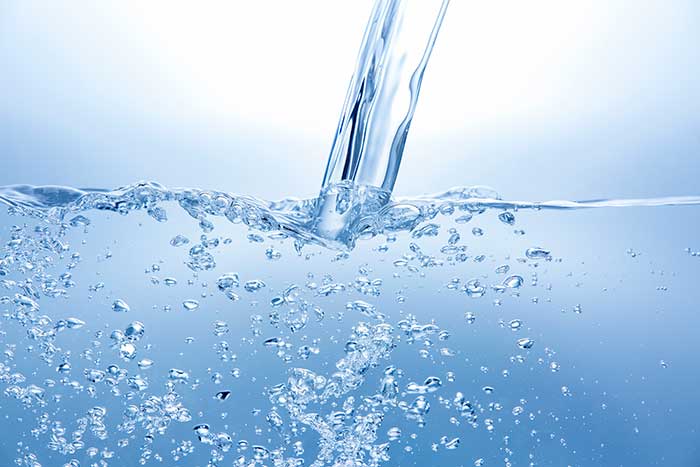
How Can I Oxygenate My Aquarium Naturally?
The easiest and best way to add oxygen to a fish tank is naturally. Creating a bioactive tank that will mostly look after itself will require you to create an environment that resembles, as closely as possible, a fish’s natural environment.
A well-cycled tank with plenty of good bacteria and live plants and a good level of filtration, lighting, and heating is all that is required to create a bioactive tank. There are many ways to add aquarium plants to your tank, such as planting, or you can attach aquarium plants to driftwood and rocks to create an eye-catching aquascape.
Live aquarium plants are a staple in any bioactive tank but need regular maintenance like the rest of the tank. Cleaning live plants once a week or bi-weekly will remove rotting leaves and the build-up of snails and algae.
Good bacteria will help control the build-up of ammonia, nitrites, and nitrates and will help prevent ammonia poisoning in your fish. Good bacteria and filtered water will prevent excess waste accumulation, one of the main causes of ammonia spikes.
High ammonia levels will have a detrimental effect on available oxygen levels, and poor water quality can cause parasites and unhealthy bacteria to grow out of control. It is not only fish that need oxygen to survive; bacteria and parasites need it and will reduce the amount of oxygen available for your fish to breathe properly.
The more balanced your fish tank, the more stable the water parameters, which is a good step toward naturally oxygenating your tank.
Lighting is important but must also be kept natural. Fish need a day/night cycle for good health, and plants require the same. Photosynthesis happens during the daylight hours when plants will provide plentiful amounts of oxygen, but they also need a night cycle when they will produce carbon dioxide.
Keeping fish tank lights on throughout the night may cause algae overgrowth, and you should avoid direct sunlight for the same reason.
A healthy bioactive fish tank will look after itself most of the time, but it will still need regular water changes, and your filter will still require cleaning.
I recommend reading an article I wrote specifically about creating a bioactive betta fish tank and the cleaning frequency of a bioactive tank. It may answer any further questions you have.
By following the above advice and not adding too many fish, the tank should produce as much oxygen naturally as required for your pet fish, and it will be quite stable.
Conclusion
Hopefully, this article has answered all of your questions about oxygenating a fish tank and how to check the oxygen levels.
Although I have provided some quick fixes, it is always best to learn how to achieve the desired results over the long term so that you can feel confident that your fish will remain in good health and be able to breathe easily.


